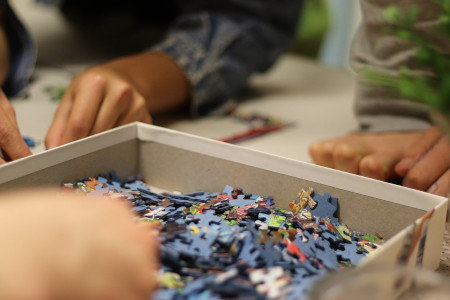Speed puzzling history can be traced back to the origins of jigsaw puzzles themselves. The concept of jigsaw puzzles dates back to the 18th century when European mapmakers mounted maps on wood and then cut them into small pieces using a jigsaw, giving rise to the term jigsaw puzzle. Initially, puzzles were seen as a leisurely and solitary activity, often enjoyed as a pastime.
Early jigsaws, known as dissections, were produced by mounting maps on sheets of hardwood and cutting along national boundaries, creating a puzzle useful mainly for the teaching of geography. Such “dissected maps” were used to teach the children of King George III and Queen Charlotte by royal governess Lady Charlotte Finch.
The name “jigsaw” came to be associated with the puzzle around 1880 when fretsaws became the tool of choice for cutting the shapes. Since fretsaws are distinct from jigsaws, the name appears to be a misnomer. Cardboard jigsaw puzzles started appearing during the late 1800s, but were slow to replace the wooden jigsaw due to the manufacturer’s belief that cardboard puzzles would be perceived as being of low quality, and the fact that profit margins on wooden jigsaws were significantly larger.
Great Depression: Cheap Entertainment
Jigsaw puzzles soared in popularity during the Great Depression, as they provided a cheap, long-lasting, recyclable form of entertainment. It was around this time that jigsaws evolved to become more complex and more appealing to adults. In some instances, they were given away in product promotions and used in advertising, with customers completing an image of the product being promoted.
Sales of wooden jigsaw puzzles fell drastically after World War II wages led to a considerable increase in manufacturing costs and ultimately price increases. Improvements in manufacturing processes also made cardboard jigsaws more attractive.
Doing jigsaw puzzles is one of many activities that can help keep the brain active and may contribute to reducing the risk of developing Alzheimer’s disease, according to the Alzheimer Society of Canada and many other organizations who have studied the health benefits of puzzles.
Betty McGregor: America’s Connection to Speed Puzzling

In 1946, there was a young woman named Betty McGregor in Minnesota who loved hosting guests and wanted to make it a party night of fun. The woman, recently married and full of delight, decided to put a clock on the table when she started playing puzzles with her guests to set a time line. Sounds like competitive speed puzzling, right? While this was a compromise for her husband, who disliked the guests playing jigsaw puzzles for hours, he agreed that everyone could participate, if, they limited the time.
The evolution of speed puzzling as a competitive activity is a more recent phenomenon. As puzzle-solving gained popularity as a form of entertainment, enthusiasts began to explore ways to add an exciting and competitive element to the traditional puzzle-solving experience. The first speed puzzling competitions started emerging in the late 20th century, with participants racing against the clock to complete puzzles of varying complexities.
This simple gesture is how speed puzzling started once again to raise attention in the Midwest. According to legend, Ms. McGregor is one of the first American to play this sport in the United States with strangers. Every Tuesday night she would open her home up to a speed puzzling competition to share the joy of this sport with others. She continued to do this at her home weekly until her husband retired years later.
This small gesture of kindness in jigsaw puzzle play actually caught on around the country. Jigsaw puzzle enthusiasts would come together in their kitchens to have mini competitions until the idea caught the eye of puzzle companies who started promoting the idea to share more puzzles in the community.
Speed Puzzling History is Rich with Diversity
There are others who have been written in books sharing the speed puzzling history, but who exactly started the craze in the United States isn’t entirely clear. It’s safe to say that speed puzzle enthusiasts were quickly playing before they were documenting speed puzzling history. Which means we really don’t know which individual revived speed puzzling and puzzle competitions in the middle of the 1900’s.

The rise of organized speed puzzling events can be attributed to the growing interest in puzzle-solving challenges, coupled with the desire for a more dynamic and social experience. Over time, speed puzzling has developed into a community-driven activity, with local events, schools, and community centers organizing competitions to bring people together in a fun and intellectually stimulating environment.
Today, speed puzzling has become a recognized and appreciated form of entertainment and competition, appealing to a diverse range of participants. The speed puzzling history is intertwined with the timeless appeal of jigsaw puzzles, evolving from a quiet and solitary activity to a vibrant and dynamic experience that combines the joy of solving puzzles with the thrill of competition.
People from all walks of life, take to finding the small pieces (and the big ones too) in a certain amount of time to solve a puzzle for completion. What is the best about this hobby is that everyone can still play, even on their own time. Which is why we love to share the best of how to speed puzzling with you! Our tips and strategies are based on firsthand knowledge. Standing at the puzzle table, waiting for the competition to begin, I know the rush of speed puzzle is something you can never explain…you just have to do it and feel it for yourself. It’s one of those hobbies you need to try before you can fully understand it.
As for speed puzzling history, I’d argue that everyone to contributed to this hobby is a star in their own right! They made the sport what it is today and we all couldn’t be more thankful!
